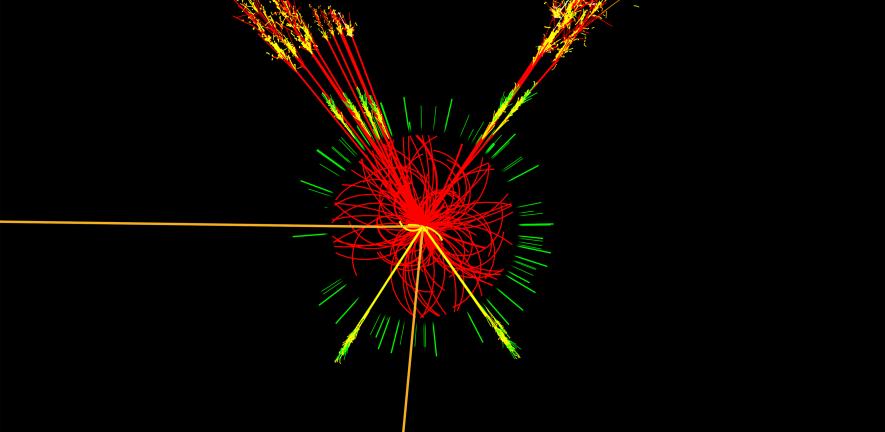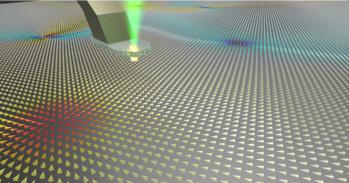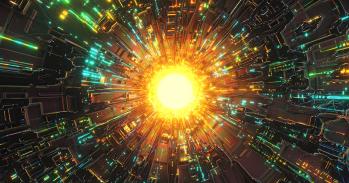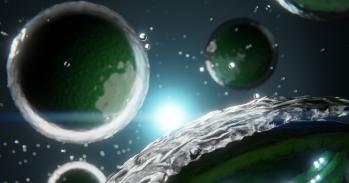
Andy Parker, Professor of High Energy Physics at the Cavendish Laboratory, sheds light on today’s announcement and ‘what next’.
Andy Parker, Professor of High Energy Physics at the Cavendish Laboratory, sheds light on today’s announcement and ‘what next’.
Cambridge has worked on the Large Hadron Collider since 1989 and was among the research groups which founded the ATLAS experiment.
Andy Parker, Professor of High Energy Physics at the Cavendish Laboratory
Researchers from the Large Hadron Collider (LHC) at CERN have today, 4 July 2012, confirmed that they have found a new particle consistent with the long-sought Higgs Boson. Thanks to the results coming from the two experiments, ATLAS and CMS, these preliminary findings appear to show a dramatic 5 sigma signal (reflecting the high level of certainty that the findings are not due to chance). They have said that if this is indeed a new particle, then it must be a boson and it would be the heaviest such particle ever found.
Andy Parker is the Professor of High Energy Physics at the University of Cambridge’s Department of Physics (the Cavendish Laboratory). His current research interests involve experiments to reveal new physics such as extra space dimensions, quantum-sized black holes, and supersymmetry. He is a founder of the ATLAS experiment for the LHC, and for 6 years he was the project leader for the ATLAS Inner Detector. Below, he answers some questions surrounding the Higgs Boson.
1. What is the Higgs Boson?
Most people imagine particles of matter to be like little billiard balls, which are stuck together in some way to make the solid objects which we see around us. We naturally expect the billiard balls to have some substance in their own right, making them, and everything which they form, massive. However, in modern quantum theories, matter is nothing like this. All the particles would, if left to themselves, have no mass at all, and fly around at the speed of light. There would be no atoms or people to study them.
The Higgs field is the proposed answer to this mismatch between our equations and what we see. The Higgs field fills all of space, and as the particles try to move through it, their interactions with it cause them to appear to have mass. This slows them down and allows them to bind together into the familiar forms of matter which we observe. This is a completely different picture of nature than the one we instinctively imagine - instead of matter having its own intrinsic properties, and moving about in empty space, many of the properties of matter are actually only due to its interactions with an invisible, all-pervasive field. The properties of "empty" space are crucial to the physicist's understanding of the world.
The Higgs boson itself is a vibration in the Higgs field, which can be created if enough energy is put into the field, like dropping a pebble into a pond. The LHC is the world’s highest energy particle collider, and the collisions it makes create enough disturbance in the Higgs field to observe the Higgs boson, if it exists.
2. Today CERN announced an update on the research, what did they find?
In December last year, CERN announced that the two large LHC experiments, ATLAS and CMS had both seen indications of extra events at one particular energy. This is consistent with what one would expect from a Higgs boson whose mass matches that energy (energy and mass are related by E=mc^2). However, there were not enough extra events to be certain that the effect was not simply due to chance. Rolling a dice and getting three sixes in a row does not prove that the dice is loaded. You need a few more sixes to be sure. In order to confirm the observation, the experiments have been collecting more data this year.
Today, the scientists at CERN have confirmed that they have found a new particle consistent with the long-sought Higgs Boson.
3. What more needs to happen for CERN scientists to confirm that the unexplained particle is indeed a Higgs Boson?
The Standard Model Higgs Boson has very specific properties. It does not exist for very long, decaying into normal particles which we observe in the detector. We know how often it should be seen in each type of decay, but to check this requires a lot of data to analyse. Once we have checked the observations in detail, it will be possible to say with much more confidence whether they are consistent with the Standard Model Higgs predictions. The LHC will continue running until the end of this year, and is expected to deliver twice as much data as we have so far. After that, it will be upgraded, and will be able to run at higher energy, which will help with the measurements.
4. In the Standard Model (the simplest theory which describes the fundamental subatomic particles and the forces between them) it is hypothesized that there is only one Higgs Boson, but in the Supersymmetric Model (which, unlike the Standard Model, incorporates the physics of dark energy and the full theory of gravitation) there could be up to five Higgs Boson. If they are able to verify the signal is indeed a Higgs Boson, how will they know if it is one of many?
The detailed decay properties of a supersymmetric Higgs Boson are different from those of the Standard Model version. Therefore, with sufficiently precise data we will be able to tell the difference.
5. If the Higgs verifies the Standard model, does more than one Higgs undermine it in favour of Supersymmetry?
Supersymmetry is an extension of the Standard Model, rather than a replacement. The Standard Model will always remain as an excellent description of Nature at energies below those explored at the LHC. But supersymmetry may be needed to explain observations at higher energies, for example if we see extra Higgs particles, or other supersymmetric partners of normal matter. This is similar to the way in which Einstein’s General Relativity is the best description of very strong gravitational fields, but Newton's gravity works perfectly well for almost all normal situations.
6. What role has Cambridge played in the research?
Cambridge has worked on the LHC since 1989 and was among the research groups which founded the ATLAS experiment. Over the years, we have done research and development on fundamental detector physics to see how the experiments could be made to work. Then we designed and built some of the major detector systems now operating at the LHC, and we continue to operate them day and night to acquire the data which is now being analysed. [I spent six years as project leader for one of the ATLAS detector systems].
Our team has always been interested in how the Higgs Boson and the Standard Model could be part of a larger picture which includes gravity, dark matter and grand-unification of particles and forces. We have benefited greatly from a long-standing collaboration between the experimental and theoretical teams at the Cavendish Laboratory, and the theorists at the University’s Department of Applied Mathematics and Theoretical Physics (DAMTP).
At present our team is studying two versions of this larger picture, using supersymmetry on one hand, and extra space dimensions on the other. Both of these ideas can answer long-standing problems in fundamental physics, and both predict the existence of more unusual particles which could be found at the LHC, including extra Higgs Bosons. We are actively searching through the data for such effects.
7. If the Higgs Boson particle(s) is confirmed, what are the next stages of research?
There will be several parallel strands of activity. The first would be to measure the properties of the observed particle in as much detail as possible, in order to check whether it is consistent with the Standard Model. The existence of a Higgs Boson at a mass around 126 GeV (gigaelectronvolt, a unit of energy equal to billion electron volts), if confirmed, would strongly suggest that other new particles are awaiting discovery. These might be supersymmetric for example. Therefore, a second strand, already under way, is to look for evidence of supersymmetry. This could be by detecting the emission of dark matter particles in LHC collisions. We are also searching directly for supersymmetric Higgs bosons. The Cambridge team is a world leader in supersymmetry research, both theoretical and experimental.
The third strand is to check for other hypotheses, of which extra space dimensions is particularly appealing. If the world has extra space dimensions, this could explain why the Higgs boson appears where it does. It seems odd that we cannot see these extra dimensions, but this is because they are supposed to be curled up into tiny circles. Looked at from afar, a piece of string looks one-dimensional, but close up, you can see an ant walk around it. Similarly, we cannot see the curled up dimensions unless we look at very short distances. The LHC works as an extremely powerful microscope which may reveal them. If extra space dimensions exist, then we would expect gravity to become much stronger at very short distances. This would be observable at the LHC, and would help to resolve the century-old puzzle of how to make quantum mechanics compatible with General Relativity.
At present, our picture of the sub-atomic world, ruled by quantum mechanics, is incompatible with our picture of the astronomical world, ruled by gravity. The Cambridge group is active in all of these areas. Once we are certain of the status of the Higgs hypothesis, it will become much easier to make testable predictions about the bigger picture. We can expect the programme of research at the LHC to continue well into the next decade.
This work is licensed under a Creative Commons Licence. If you use this content on your site please link back to this page.





